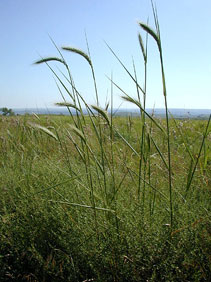CANADA WILD RYE
|
 |
| File Size: 110 KB |
|
|
|
Elymus canadensis L.
|
| Riley County, Kansas |
| Perennial |
| Height: 3-6 feet |
| Family: Poaceae - Grass Family |
| Flowering Period: July, August |
|
| Culms: | | Erect, slender to stout, hollow, glabrous, green or blue-green waxy. | | Blades: | | Flat or rolled inward, 4-16 inches long, .25 to .5 inch wide, slightly narrowed toward bases, midrib prominent beneath, rough or bristly-hairy above; margins fine-toothed; tips tapered to fine points. | | Sheaths: | | Mostly longer than internodes, rounded, usually glabrous; auricles prominent, finger-like, clasping. | | Ligules: | | Short, membranous, entire or notched. | | Inflorescences: | | Spikes, dense, erect or nodding, 3-12 inches long, occasionally interrupted below, terminal. | | Spikelets: | | 1-4 per node, overlapping, slightly spreading, sessile, 2-7-flowered; glumes equal, shorter than first lemma; lemma awns .5 to 1.5 inch long, outward curving at maturity. | | Habitat: | | Moist or dry open prairies, stream banks, ditches, and disturbed areas, more abundant on sandy or rocky soils. | | Distribution: | | Throughout Kansas. | | Toxicity: | | Ergot can infest the inflorescence and is potentially dangerous to livestock. | | Forage Value: | | Canada wild rye is very palatable and nutritious and is readily grazed by livestock. The forage value decreases with age. | | Comments: | | Tufted. Sometimes called "nodding wild rye" because of the arching heads. It is winter hardy and grows as far north as southern Alaska. |
|
| Canada wild rye |  | | 82 KB | | Riley County, Kansas |
| | Canada wild rye inflorescence |  | | 137 KB | | Konza Prairie, Riley County, Kansas |
| | Canada wild rye |  | | 118 KB | | Ottawa County, Kansas |
| | Canada wild rye |  | | 30 KB | | Tallgrass Prairie National Preserve, Chase County, Kansas |
| | Canada wild rye inflorescence |  | | 82 KB | | Marshall County, Kansas |
| | Canada wild rye |  | | 95 KB | | Marshall County, Kansas |
| | Canada wild rye habit |  | | 214 KB | | Riley County, Kansas |
| | Canada wild rye inflorescences |  | | 108 KB | | Riley County, Kansas |
| | Canada wild rye mature inflorescences |  | | 245 KB | | Morris County, Kansas |
| | Canada wild rye inflorescence |  | | 129 KB | | Riley County, Kansas |
| | |
|
|
|
|
|
|